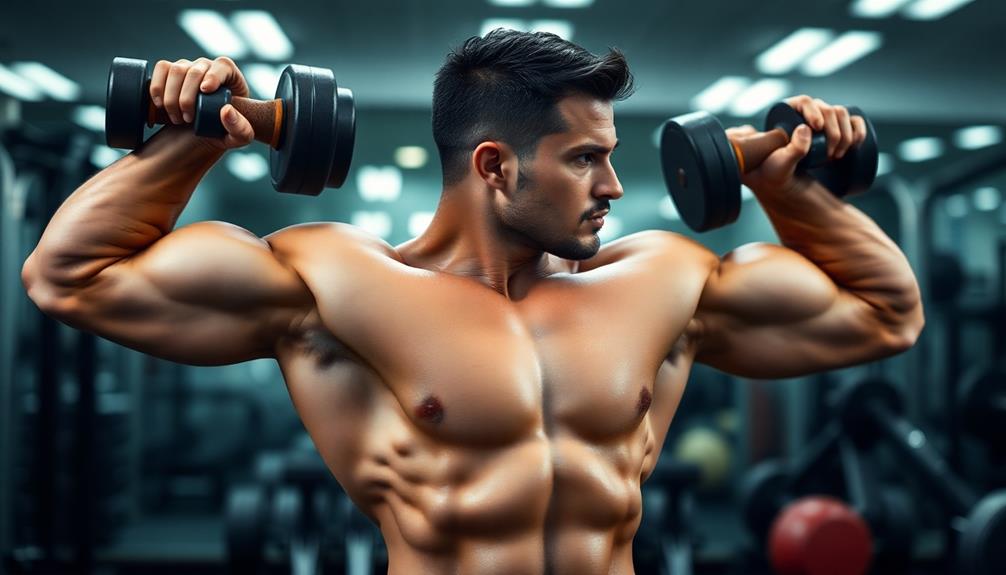To build strong shoulders, start with a proper warm-up, including arm circles and light cardio. Focus on key exercises like overhead presses, lateral raises, and rotator cuff movements. Use dumbbells, resistance bands, or cable machines to target all shoulder sections. Gradually increase weight and reps for progressive overload. Incorporate variety in your routine, balancing front, side, and rear deltoid work. Don't forget to include exercises for supporting muscles like rhomboids. Allow adequate recovery time between sessions and maintain proper form to prevent injuries. By following these steps, you'll be on your way to developing powerful, well-rounded shoulders. Let's explore each component in detail.
Core Insight
- Begin with proper warm-up exercises like arm circles and shoulder rolls to prepare muscles for training.
- Start with basic exercises like overhead presses and lateral raises using light weights to establish proper form.
- Gradually increase weight and resistance as strength improves, following the principle of progressive overload.
- Incorporate a variety of exercises targeting all deltoid sections (front, side, and rear) for balanced muscle development.
- Include rotator cuff strengthening exercises to support overall shoulder health and prevent injuries during training.
Understanding Shoulder Anatomy

Building strong shoulders starts with understanding their anatomy. Your shoulder is a ball-and-socket joint that lets you move your arm in many directions. It has three main bones: the upper arm bone, shoulder blade, and collarbone. Resistance tubes are great for targeting the shoulder muscles. They come in different resistance levels for rehab or strength training.
The four main shoulder muscle groups are:
- Deltoids: The most visible muscles, with front, side and back sections.
- Rotator cuff: Four small muscles that keep the joint stable.
- Trapezius: A large muscle from the neck to mid-back.
- Rhomboids: Muscles between the shoulder blades for good posture.
Knowing these parts helps you work out effectively. It leads to even shoulder development and lowers injury risk.
Essential Equipment for Shoulder Training

To build strong shoulders, you'll need the right equipment. Dumbbells in different weights are a must-have, so you can increase the challenge as you get stronger. Resistance bands are great because they're easy to carry and can work different parts of your shoulders. A barbell with weight plates is perfect for exercises like military presses. If you want something that's easy to use anywhere, try a TRX system. These are lightweight and offer tons of workout options, including exercises for your shoulders.
An adjustable weight bench is useful for seated exercises and support. Cable machines keep your muscles working throughout each move, which is great for building strength. A pull-up bar is essential for bodyweight exercises.
Don't forget about tools like exercise balls or balance boards. These challenge the smaller muscles that help stabilize your shoulders. Lastly, make sure you have comfortable workout clothes and shoes. This will keep you safe and supported during your training. With this equipment, you'll be ready to build strong, defined shoulders.
Warm-Up Routines for Shoulder Workouts

A good warm-up is key for a safe and effective shoulder workout. Start with some light cardio for 5-10 minutes to get your blood pumping. Then, do arm circles forward and backward to loosen your shoulder joints. Next, roll your shoulders up, back, and down smoothly. Do dynamic stretches like arm swings and cross-body pulls to improve flexibility. A foam roller can also help release muscle tension before you start. Finish with a few sets of light lateral or front raises. This will activate your shoulder muscles and lower your risk of injury during the main workout.
Overhead Press Techniques
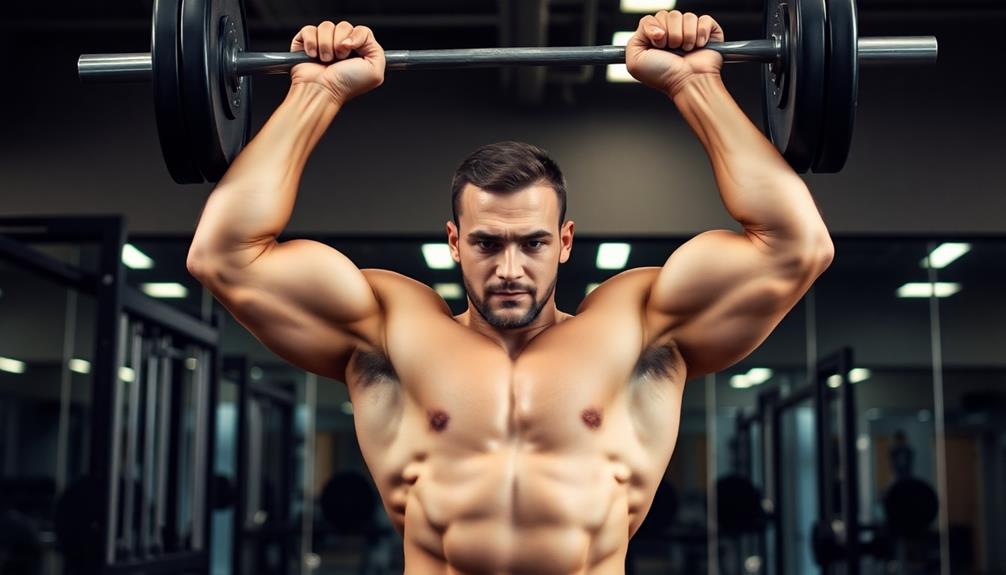
The overhead press is a key exercise for strong, defined shoulders. Here's how to do it right:
- Stand with feet shoulder-width apart
- Hold the bar a bit wider than your shoulders
- Tighten your abs and keep your back straight
- Press the bar straight up, not out in front
- Straighten your arms all the way at the top
Push through your heels and use your whole body as you press. Don't lean back or let your back arch. Keep steady and lined up. Rolling your shoulders with a foam roller after working out can ease tightness and help them move better. Breathe out on the way up, in on the way down. Start with a weight you can do 8-12 times with good form. Add weight slowly as you get stronger. Using proper form keeps you safe and gets the best results.
Lateral Raise Variations
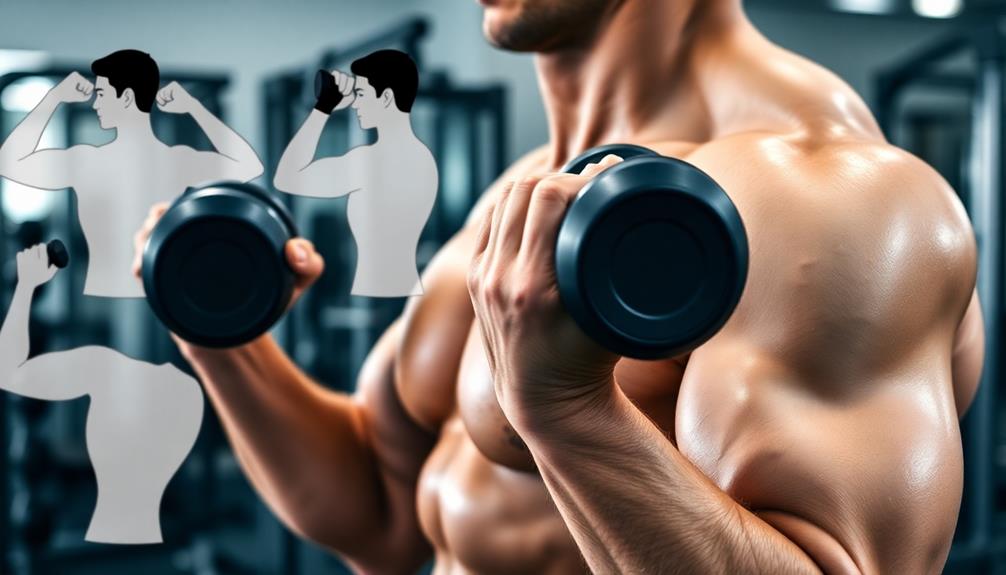
Lateral Raise Variations
Want to sculpt defined shoulders? Lateral raises are a great exercise, and you can do them in different ways to work all parts of your shoulder muscles. Before you start, try using a foam roller to warm up your shoulders and improve flexibility. This will help you get more out of your workout.
- Standard Lateral Raise: Stand holding dumbbells at your sides. Raise your arms out to the side until they're at shoulder level.
- Seated Lateral Raise: Do the same thing, but sit down. This helps you focus just on your shoulders.
- Cable Lateral Raise: Use a cable machine to keep tension on your muscles the whole time.
- Front Lateral Raise: Raise the weights in front of you instead of out to the sides.
- Bent-Over Lateral Raise: Bend forward at your waist and raise the weights. This targets the back of your shoulders.
- Single-Arm Lateral Raise: Work one arm at a time to really feel the muscle working.
Make sure you use good form and control the weights through each rep. This will help you get the best results and avoid injuries.
Rear Deltoid Exercises
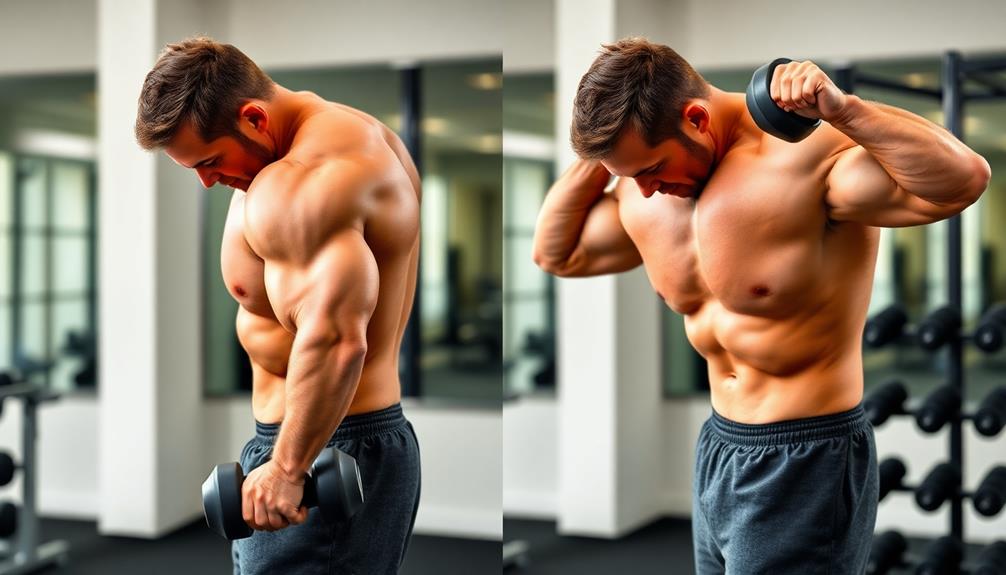
To balance your shoulder development, don't forget about your rear deltoids. Include these exercises in your routine:
- Bent-over dumbbell flyes: Hinge at your hips, keep your back straight, and lift dumbbells out to the sides
- Face pulls: Use a cable machine and pull the rope towards your face, squeezing your shoulder blades together
- Reverse cable flyes: Isolate your rear delts effectively with this cable exercise
- Seated rear delt machine: Provides stability for beginners targeting the rear delts
- Prone Y-raises: Challenge your rear delts and upper back at the same time on an incline bench
Start light to nail your form before increasing weight. Massage balls can help release tension and improve flexibility in your shoulders after training. The size and shape of the ball matters for the best results in your recovery.
Rotator Cuff Strengthening
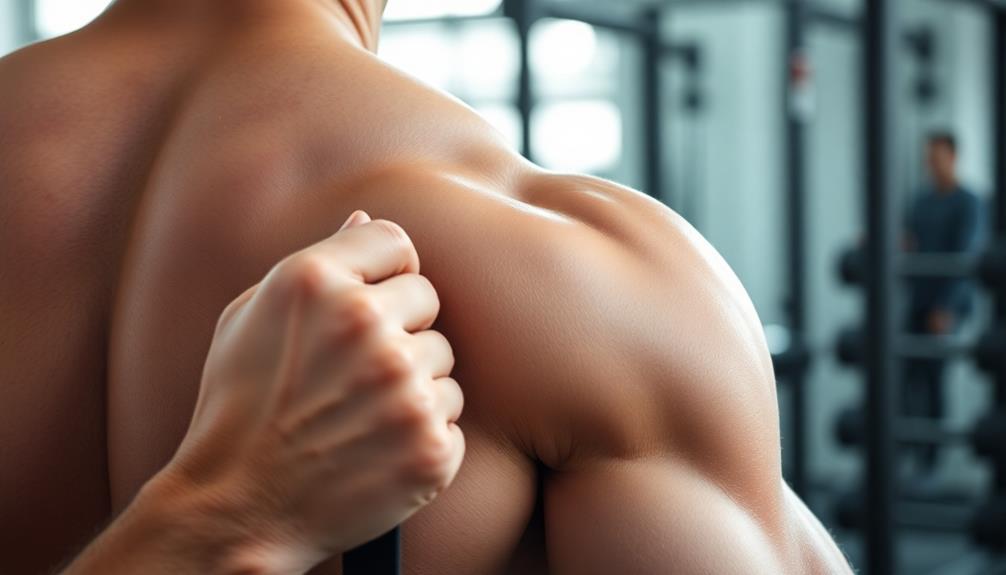
Keeping your shoulder joints healthy is crucial, and one way to do that is by strengthening your rotator cuff muscles. These small but mighty muscles help stabilize your shoulders and prevent injuries. Resistance bands are a great tool for targeting your rotator cuff, and they're easy to use at home or on the go.
Try adding these simple exercises to your routine:
- External Rotation: Keep your elbow at your side and use a band to rotate your arm outward.
- Internal Rotation: Same as external rotation, but rotate your arm inward.
- Shoulder Blade Squeeze: Squeeze your shoulder blades together and hold.
- Arm Circles: Make small circles with your arms, then gradually make them bigger.
- Y-Raises: Use light weights to raise your arms diagonally, forming a Y-shape.
Aim to do these exercises 2-3 times per week. Start with light resistance and focus on doing the movements correctly. Try 2-3 sets of 10-15 reps for each exercise. With consistency, you'll notice improvements in your shoulder strength and stability.
Progressive Overload for Shoulder Development
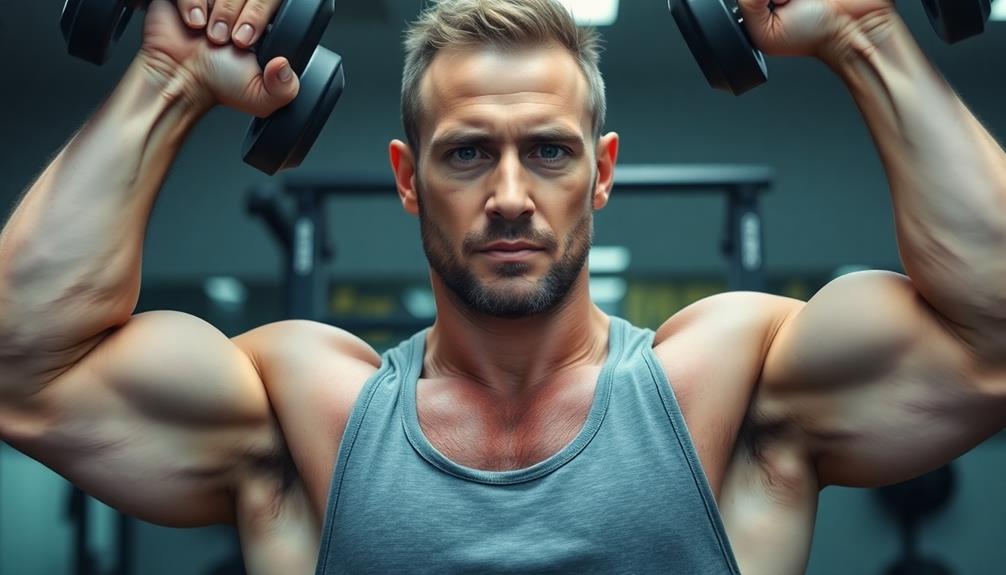
Progressive overload is key for building strong, defined shoulders. To keep your muscles growing, you need to slowly increase the work they do over time. This helps you avoid plateaus in your training. Resistance tubes are a great tool for progressive overload because they come in weights from 2 lbs to over 40 lbs and are easy to take with you.
Here are some ways to use progressive overload for your shoulders:
- Use heavier weights
- Do more reps in each set
- Add more sets of each exercise
- Take shorter rests between sets
- Try harder versions of exercises
As you do these things, watch your form and pay attention to how your body feels. Challenge yourself, but don't push so hard that you get hurt. Start with one or two of these methods and change your plan if needed. The most important thing for building your shoulders is sticking with progressive overload over time.
Recovery and Injury Prevention

Keeping your shoulders healthy is key to building strength over time. Make sure to warm up, cool down, and stretch whenever you work out. Use proper form and technique, and ask a trainer for help if you need it.
Follow these tips to keep your shoulders in good shape:
| Recovery Method | What It Does |
|---|---|
| Get enough sleep | Helps muscles heal |
| Eat right | Helps tissue recover |
| Take active rest days | Keeps you flexible |
| Use a foam roller | Loosens tight muscles |
| Try ice or heat | Reduces swelling |
Pay attention to how your body feels and take breaks when needed. See a doctor if your shoulders hurt for a long time. These tips will help you get stronger shoulders while avoiding injuries.
Integrating Shoulders Into Full-Body Workouts

Shoulders are an important part of a full-body workout. Adding shoulder exercises helps you build balanced muscles and prevents imbalances. Resistance bands with handles or door anchors let you do shoulder exercises at home and change the resistance level as needed. Here are some tips for adding shoulder exercises to your routine:
- Do shoulder exercises with leg movements to save time
- Switch between pushing and pulling exercises for balance
- Use exercises that work your shoulders indirectly
- Combine shoulder and core exercises in supersets
- Do one-sided exercises to improve stability
Frequently Asked Questions
Can I Build Strong Shoulders Without Weights or Gym Equipment?
Yes, you can build strong shoulders without weights or gym equipment. You'll need to focus on bodyweight exercises like push-ups, handstands, pike push-ups, and dips. Incorporate resistance bands or household items for added challenge if desired.
How Long Does It Typically Take to See Noticeable Shoulder Gains?
You'll typically see noticeable shoulder gains in 6-8 weeks with consistent training. However, it varies based on factors like your starting point, workout intensity, nutrition, and genetics. Stay patient and keep pushing; results will come!
Are Certain Shoulder Exercises More Effective for Women Than Men?
While there aren't exercises specifically more effective for women, you'll want to focus on overall shoulder development. Don't shy away from lifting heavy. Incorporate a mix of pressing, lateral raises, and rear delt exercises for balanced growth.
Can Shoulder Training Help Improve Posture and Reduce Neck Pain?
Yes, shoulder training can markedly improve your posture and reduce neck pain. By strengthening your shoulder muscles, you'll support your upper body better, alleviating strain on your neck and promoting a more upright, aligned posture.
Should I Train Shoulders on the Same Day as Chest or Back?
You can train shoulders with chest or back, but it's often better to pair them with chest. This allows you to hit all upper body push movements together, maximizing efficiency and reducing potential overuse of shoulder muscles.

